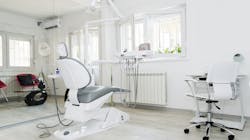Study: Managing carbon dioxide levels in operatories can reduce disease risk
A new study on carbon dioxide levels in closed operatories showed that dentists could easily monitor CO2 —elevated levels of which are long associated with increased transmission of infectious respiratory diseases like COVID-19—with a simple device and if needed, improve ventilation to reduce risk.
Ventilation Assessment by Carbon Dioxide Levels in Dental Treatment Rooms, published in the Journal of Dental Research (JDR), evaluated CO2 levels in 10 dental operatories. The study measured mechanical ventilation rate in air change per hour with an air velocity sensor and air flow balancing hood. Results indicated CO2 levels in dental treatment rooms could be measured with a simple consumer-grade CO2 sensor, and that dental professionals could determine ventilation rate by either natural or experimental buildup of CO2 levels in operatory settings.
Increased CO2 levels have long been associated with the transmission of infectious respiratory diseases such as tuberculosis, influenza, and rhinovirus infections; as such, it’s considered a risk marker for such transmission.
Access the full study: Ventilation Assessment by Carbon Dioxide Levels in Dental Treatment Rooms.
